
- HOME
- 506TH STORY
- SQUADRONS
- PILOTS
- IWO TO JAPAN
- MAY/JUNE MISSIONS
- MAY/JUNE MISSIONS
- MAY 28th | TOKYO AREA AIRFIELDS
- JUNE 1st | BLACK FRIDAY 25 Pilots Lost
- JUNE 7th | OSAKA | 138 P-51s of 15th, 21st and 506th Groups
- JUNE 8th | NAGOYA AREA
- JUNE 9th | NAGOYA AREA
- JUNE 10th | TOKYO AREA
- JUNE 11th | TOKYO AREA
- JUNE 14th | BONIN ISLANDS
- JUNE 15th | OSAKA AREA
- JUNE 19th | TOKYO AREA AIRFIELDS
- JUNE 23rd | TOKYO AREA
- JULY MISSIONS
- JULY MISSIONS
- JULY 1st | TOKYO AREA five enemy aircraft destroyed, seven damaged
- JULY 3rd | DEATH AT CHI CHI
- JULY 4th | TOKYO AIRFIELDS
- JULY 5th | TOKYO AIRFIELDS
- JULY 6th | TOKYO AIRFIELDS
- JULY 7th | WEATHER ABORT
- JULY 8th | TOKYO AIRFIELDS
- JULY 9th | TOKYO AIRFIELDS Sixteen enemy aircraft destroyed, five probably destroyed and eleven damaged
- JULY 14th | NAGOYA AIRFIELDS
- JULY 15th | NAGOYA AIRFIELDS
- JULY 16th | CAPT BENBOW LOST/AUST DOWNS 3
- JULY 19th | NAGOYA/OSAKA
- JULY 20th | NAGOYA AREA
- JULY 22nd | OSAKA/NORTHEAST SHIKOKU
- JULY 24th | NAGOYA AREA
- JULY 28th | NAGITA AREA
- JULY 30 | KOBE/OSAKA
- AUG MISSIONS
506th Fighter Group - Iwo to Japan
Their heritage began at Pearl Harbor
PAGE 1
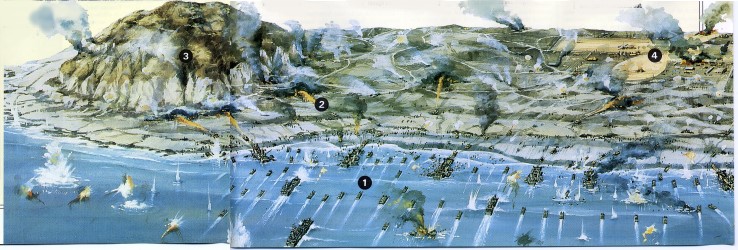
Iwo Jima also served as the base for four Groups and two Squadrons of the VII Fighter Command flying P-51s, P-47s and P-61s and assigned to the 20th Air Force. From Apr to Aug 45 they flew 51 escort and strike missions over Japan, damaged or destroyed 1,062 enemy aircraft and lost 114 fighters in combat. By war's end the Iwo Fighter Groups numbered over 11,000 men with 174 killed or missing in action.
Iwo To Japan | Pg 1 | Pg 2 | Pg 3 | Webmaster Notes
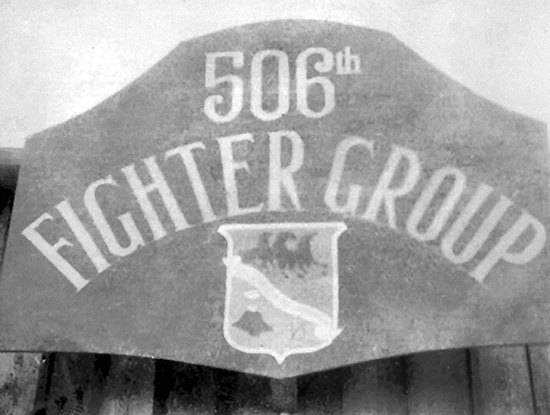
Missions to Japan |
|||
May/June
|
June
|
July/August
|
|
|
|
|
The nature of war in the Central Pacific had been different from any other. The operational objectives had not been to gain land masses or capture cities. Rather, each island objective seized became an airfield from which the next jump forward could be supported. For the B-29's Super fortress of the XXI Bomber Command, the Marianas represented the beginning of the war's final phase. From bases on Guam(MAP), Tinian(Map)(Satellite View), and Saipan (MAP)(Satellite View)the heavy bombers were finally within range of Japan proper. Beginning on Thanksgiving Day 1944, the Super fortress massive bomb loads would be directed at Japan's industrial centers.
There were two critical shortcomings of the Marianas (MAP) bases that would have to be solved before the full destructive power of the bombers could be realized. First was the lack of a suitable divert field for battle damaged or fuel-deficient aircraft if they could not make the 1,500-mile over-water return trip. Second, and more critical, was the lack of fighter escort. Occasionally the bombers would run into a cloud of as many as 300 Japanese fighters over their target area and have to fend off as many as 600 individual attacks during the 45 minutes, or longer, they were over Japan. While the enemy's air arm was in decline, a new threat had emerged that threatened for awhile to halt to B-29's operations - the Kamikaze. Kamikaze pilots seemed unstoppable as they flung their aircraft in suicide missions against targets in the air or on the surface. Even if hit repeatedly by the bomber's gunners, they were often able to maintain enough control of their aircraft to crash into a vulnerable Super-fortress. A small, volcanic island a little more than five miles long and barely two miles across was the answer to both of these problems.
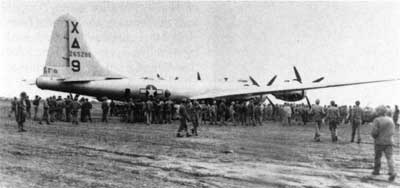
Dinah Might of the USAAF 9th Bomb Group
As early as March 4, 1945, while fighting was still taking place, the B-29 bomber Dinah Might of the USAAF 9th Bomb Group reported it was low on fuel near the island and requested an emergency landing. Despite enemy fire, the airplane landed on the Allied-controlled section of the island, without incident, and was serviced, refueled and departed. In all, 2,251 B-29 Super fortresses landed on Iwo Jima during the war.
Yet the invasion of Iwo Jima (Map)(Satellite View) began paying off almost immediately.
Letters From Iwo Jima
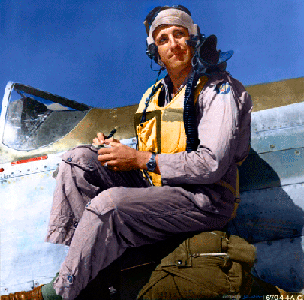
CAPT. JJ GRANT 462ND
#615 "My Bonnie" as a Lt. then promoted to #607 "DOLLY" as a Capt.
Lt. Proctor Thompson Group Headquarters Ground Echelon
"After nearly a month of waiting, on Monday, 5 March, the first section of our troop train pulled into the siding at LAAB; the 457th, half the 458th boarded and began the journey to Seattle. They were followed, that afternoon, by a train filled with the 462nd and the remaining half of the 458th. The trip was long, filled with scenery and poker and the exchange of tidy sums.
At Fort Lawton staging area, the processing routine was simple: a perfunctory medical examination, a lecture on censorship, a session at the obstacle course, and the inspection of weapons."
Two P-51 groups were ready to move into Iwo just as soon as facilities could be readied for them. The Mustang's seven-league boots were legendary in the European Theater, where the war was almost over, as Eighth and Ninth Air Force P-51 s easily flew from southeastern England to Berlin and back, nearly 1,200 statute miles. A few 1,500-mile shuttle missions from England to the Ukraine had also been undertaken, but once P-51s were based on Iwo they would fly round-trips of that distance as a matter of routine.
May 1945
Pilots of the air echelon in P-51D aircraft arrived Iwo Jima (Map)(Satellite View) from Tinian (Map)(Satellite View) on 11 May 1945. Ground personnel of the air echelon arrived Iwo Jima in Transport Air Group from Tinian C-46's on 19 May l945.
Strength, 1 May I945: 64 Officers, 254 EM Strength, 31 May 1945: 68 Officers, 254 EM
Planes on hand, 1 May 1945: 25 P-51D's
Planes on hand, 31 May 1945: 25 P-51D's
Losses Four (4) P-51D aircraft as follows:
13 May 1945 - Lt Carter crashed on landing. Lt Carter was killed in the crash of his P-51D when he undershot the southwest runway of North Field at the conclusion of a weather check flight.
18 May 1945 - Lt. Veld ran off the end of the runway.
23 May 1945 - Captain K. M. Miller crashed on Imba K/7, Japan, presumably by enemy ground fire, while on a strafing run.
27 May - Lt Torgerson bailed out at sea.
506th Arrives
From the 1st to the 10th of May the air echelon pilots were engaged in perfecting mutual support tactics cc West Field #4 Tinian (Map)(Satellite View) and awaiting a weather clearance for the trip to Iwo Jima (Map)(Satellite View) . Information was sent to AAFICA and ISCOM Tinian by 7th Fighter Command that North Field (see maps above) would be ready for the Air Echelon by noon of the 5th. Weather was not the only factor hampering the schedules arrival of the Echelon. Supply shortages, 110 gallon wing tanks in this case, played their usual role increasingly impatient with the promises that the tanks would arrive at Tinian *any day now* the air Echelon flew it's ships to Depot Field, Guam (MAP)(Satellite View) and installed the tanks and returned to West Field #4 for the finishing touches by maintenance personnel. B-29 escort having been secured for the 313th Wing, the trip was accomplished about noon on the 11th. (At Tinian from 1 to 10 May a total of 222.5 hours of flying time were logged by the 506th pilots)
Unit History 506th Fighter Group May 1945 Epilogue
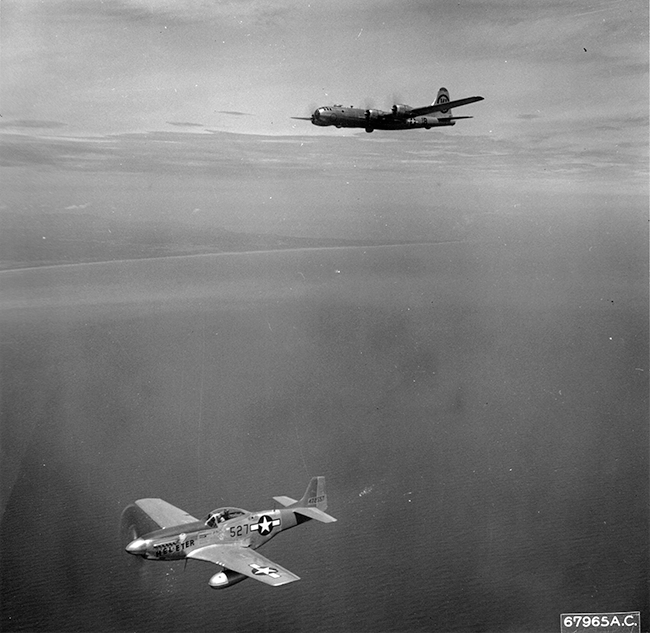
527 HEL-ETER escorting a B-29 bomber on way to bombing mission over Japan.
note wing tank.
Orderly room soldiers who had never done anything more risky than jump off the moving creeper at Hickam Field were suddenly pulling guard on a battlefield through long terror-filled nights. Pandanus tree skeletons waved weirdly against the sky, rocks clattered down the slopes of Suribachi, trip-flares shot suddenly skyward from the incredible confusion of the supply-jammed beaches, terrified animals darted about, and through the night Japs crept from their caves in search of food and water, flung grenades from out of nowhere. Iwo was never silent. Guards fired at the slightest rustle. Men lay tensely awake in their foxholes, listening to shells lobbed in from the north end of the island, the scattered pop of carbine's and the dreary roar of surf breaking over wrecked landing barges. Unending was the clang of the engineers and Seabees who worked all day under the dust-veiled sun and all night under the glare of arc lights moving the shell-torn earth. Never in this Pacific war was so much fighting and dying, heaving, hauling and building crowded into so little space. Iwo was the Japs' isle of desperation and the Japs died for every handful of its dust. The only apparent sign of order in the incredible confusion was the geometric pattern of white crosses. But Iwo had to be lived on, too. On March 4, a B-29 returning from the Empire made the first emergency landing on Iwo Jima. It was no corny impulse which made crewmen stoop and kiss the sulfur-fouled ash of the island. It had saved them from the watery end that had claimed so many of their buddies in fatal ditchings. Now when weather cut their fuel margin, or when battle damage killed their engines, they could live to fly another mission. When the Iwo Combat Staging Center got into high gear, as many as 50 to 60 Super-forts were landing at one time for essential repairs after tough raids or to fuel up for extra long missions.
Fighter pilots came in early, early enough to die horribly in the banzai attack when a band of Japs slit into their tents at dawn. The pilots and ground personnel fought them off like infantrymen. So when Mustangs got off on their first Empire mission on April 7 escorting B-29s to Tokyo, they had a highly personal score to settle with the Nips. Many Jap fighters went down before the guns of Iwo Mustang pilots. And P-5I kills in the air rapidly spelled the end of Jap ability or will. When aerial resistance faltered, Iwo fighters took to the dangerous task of ground strafing. Scores of Jap planes, hangars and ships were shot rocketed to bits. By V-J day Iwo was shaped up into a first class Pacific base and had balanced the high price Americans paid for its possession.
Arriving at Iwo
May 8th
On the 8th two fatal accidents to one in which engine failure on takeoff was a contributory factor, served to pour additional oil on troubled fires. Fortunately the crew chiefs, the engineering officers, and the other members of the Air Echelon left behind at Tinian were transported on TAG aircraft to Iwo on the 19th. To the 90,003 pounds of freight originally loaded on CVE Kalinin Bay had been added at least 22,000 more pounds of such high priority items as plywood, desks, tables, and spare parts salvaged from wrecked aircraft. The products of diligent persuasive Major Storys campaign on Guam were also ferried to Iwo in TAG aircraft.
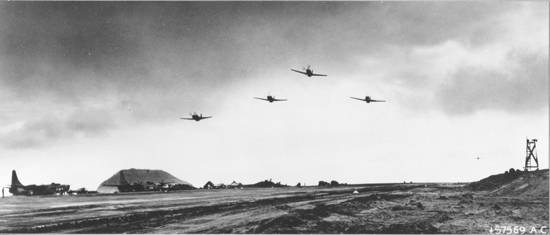 |
A flight of four P-51D Mustangs returning home from a mission to Iwo Jima. (USAF) |
The fighter strength of the 506th now stood at 74 planes (457th – 27; 458th – 22; 462nd – 25) and 156 pilots (52 per squadron). Not included in this total were the Group rated officers who were ferried out to the Squadron for flying duty. At long last the Group was united as a fighting organization. Before we tangled with the Nips, the eager birdmen of the 506th had to serve an apprenticeship in CAP missions for the air defense of Iwo. Most especially was this true of the pilots of the ground echelon who had not been inside a plane since early February.
As prescribed by Fighter Command, CAP was to consist of 4 ships airborne and 12 ships on alert during the main part of the day; 8 ships were to be airborne and 8 on standby one hour before and after dawn and one hour before dusk. When VLR missions were returning, 12 ships were to be airborne and 4 on alert. It was decided that the Squadron schedules for CAP was to provide 8 aircraft and the other two squadrons 4 aircraft each with the scheduled Squadron maintaining the airborne flights and the others keeping stand-by-alert only. Beginning the 16th the Group flew a total of 202 CAP sorties during May.
The satisfaction experienced by the 506th pilots at getting into harness again was tempered by a slight feeling of anxiety regarding the maintenance of their aircraft. With most of the crew chiefs chiefs and the three squadrons engineering officers cooling their heels at Tinian, CAP sorties and the forthcoming strikes against the Bonin Islands would be fraught with entirely unnecessary hazards.
In its capacity as the Air Defense Command of Iwo, our higher headquarters, VII Fighter Command, is responsible for conducting strikes against a rocky inhospitable island, 150 nautical miles at an approximate heading of 19° from Iwo, known as Chichi Jima. Located on Chichi, headquarters of the Japs Bonin Island garrisons, is a harbor (Futami), miscellaneous docks, troop housings, radio and radar facilities and a small bomb pocked airfield (Susaki). To keep this field inoperative, a daily sortie is flown by VII Fighter Command aircraft with two five hundred pound bombs under their wings.
When the 506th F. G. with the 457th, 458th and 462nd squadrons arrived in mid-May, some of the strain of operations was eased for the first two groups. The 506th alternated with the 15th and 21st in making two-group missions to Japanese Empire targets, so one of the three could anticipate a stand-down when the schedule was set. It also allowed more time for crucial maintenance.
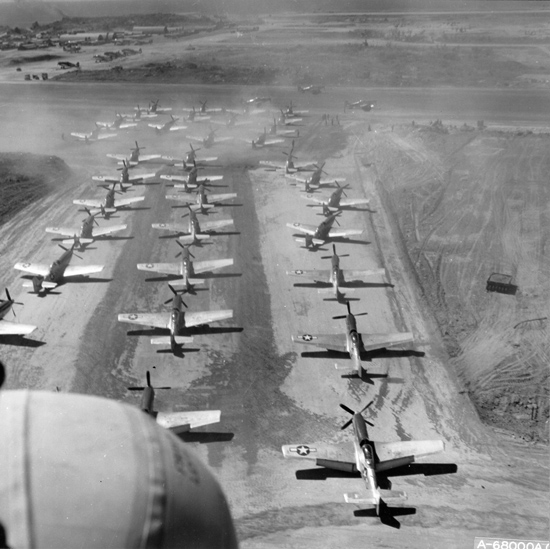
An official USAAF photo shows P-51 Mustangs of the 506th Fighter Group taxi to the runway for take off on a mission strike to Japan.
One P-47N group, the 414th under Col. Hank Thorne, arrived in late July but was only active from Iwo for five weeks before the surrender. The yellow-and-black marked Thunderbolts primarily flew ground support, though some missions were made to Japan.
The comment that "maintenance on Iwo was tops" seems universal among the 51 jocks. If a pilot wanted a new carburetor all he had to do was mention it. Many crew chiefs kept their aircraft waxed and sanded for extra speed, though some joked it was because there was nothing else to do on Iwo. The mechanics conscientiously changed spark plugs after every VLR mission to avoid fouling later on, as the prolonged low-RPM cruising from Japan tended to burn up plugs.
Lt. Harve Phipps of the 72nd F. S. recalls, "The maintenance crews were excellent. The squadron had been in the Seventh from the beginning and the crew people were not rotated very often. They were experienced and we had practically no aborts because of maintenance. Pilots genuinely appreciated such hard-working mechanics; the last thing in the world they needed to worry about was engine failure 600 saltwater miles from home."
 Letters from Iwo Jima: The Air War: May 11th: The Echelon Arrives From Tinian.
Letters from Iwo Jima: The Air War: May 11th: The Echelon Arrives From Tinian.
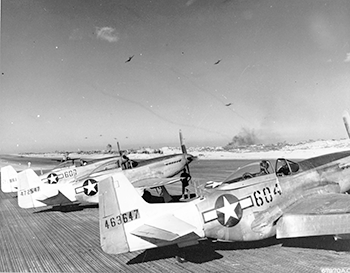
A flight of four P-51D Mustangs returning home from a mission to Iwo Jima. (USAF)
Read more about the landing technique used on Iwo: Mustangs of Iwo
The appearance of reinforcements did nothing to rectify or relieve the psychological pressures that were brewing. The 506th Fighter Group, trained for VLR operations from its inception, and led by Colonel Bryan B. Harper, arrived from the States with 85 new Mustangs. It had an orphan's status, being assigned to the Twentieth Air Force, carried under the organization of the 301st Fighter Wing (then on Okinawa) and attached to the Seventh Fighter Command. The muddled chain of command made little difference to the pilots, however, and after taking a few pokes at Chichi Jima they were anxious for the main event. Their maiden effort was a strike against Kasumigaura Airfield on 28 May, and they made a credible showing, destroying or damaging some 50 parked aircraft and destroying one in the air for the loss of two planes and one pilot.
(60) By now, the 20th Air Force was nearing full strength -1,000 Super forts and 83,000 men. The manufacturing capability of five of Japan's major cities had been demolished. Furthermore, the mining of their waters had cost them nearly a million tons of vital shipping. The B-29s swarmed like flies over Japan, bombing day and night, against ever weakening fighter opposition. The simultaneous bombing of multiple targets had paralyzed their efforts to retaliate effectively. Their air force was becoming pitifully short of aircraft and they were saving most of these for the anticipated American invasion of their homeland.
27 May, our crew was ordered to Iwo Jima for a period of "DS" (detached service). The purpose of the assignment was two-fold: to participate in search missions for downed B-29 fliers along the Japanese coast; and to act as navigation plane for P-51s in a forthcoming strike against the seaport of Yokohama. These 1,500 mile escort missions would be the longest in fighter aircraft history. As we looked down on the tiny five and one-half mile long island, certain features stood out conspicuously. The overall view of pork chop—shaped Iwo was one of ugliness and desolation, its black volcanic ash much like the surface of the moon. Rising 556 feet at its southern tip stood historic Mount Suribachi, an inactive volcano. It was here that the valiant Fifth Marine Division had fought its way bitterly to the top. There in one of the most memorable scenes of World War II, they had planted the U. S. flag on the brim of its deep crater. Highly visible, too, were the island's three airfields situated on a flat ridge, and identified simply as Motoyama #1, #2, and #3. The most impressive sight of all, though, were Iwo's three cemeteries, each with its long orderly rows of white crosses. They stood in striking contrast against the black sandy background; the final resting places of over 6,800 Americans lost in the battle for Iwo. Add to this about 19,000 injured, and it ranked as one of the bloodiest of all battles in American history.
Out of an estimated 21,000 Japanese troops, only 1,000 had been taken prisoner. The rest died in combat, were incinerated or sealed in caves, or chose to die by committing suicide. There were 353 Congressional Medals of Honor bestowed during the four years of World War II, both in Europe and the Pacific. Of this number, 27 of them went to the veterans of Iwo in an operation lasting just over a month. Our quarters, a twelve man tent, sat at the base of a steep bluff. Outfitted with canvas cots, it housed our entire crew, both officers and enlisted men. Our meals were a daily repetition of dehydrated foods, designated in the military as "C" or "K" rations. No matter how they were served - cold, heated, or in between - they tasted the same — bad.
28 May, came the call for our first mission out of Iwo Jima. We were to serve as a navigation plane for P-51s in a flight to Japan. They in turn would provide fighter escort for a B-29 strike on Yokohama. Each "mother Superfort" would be responsible for taking four Mustangs up to the Japanese coast. There the P-51s would accompany bomb-laden B-29s into and away from the target. Upon withdrawal, each of the “chickens" would rendezvous with its "mother" and be shepherded back to Iwo. Of interest on this mission was an attempt by a Jap fighter to sneak in on us. He made one pass, only to be promptly shot down by one of the Mustangs. Accompanying us, as passenger, on this eight and one-half hour mission, was a Lt. Reider of a Sea Bee group on Iwo Jima. This marked the beginning of a strong friendship between members of his unit and Crew Five.
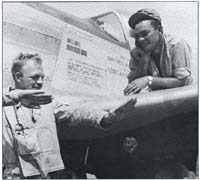 |
Capt. Pete Nowick shows Crew Chief, S/Sgt. John Stanfield how he bagged a pair of Japanese planes on a 10 June 1945 escort mission. (USAF) |
VLR Mission No 13 (FC Mission #161) 28 May 1945
Force: 53 P-51s' of the 506th Group
Mission: Fighter Strike against airfields in Tokyo area
Claims against enemy: 1 destroyed and 2 damaged in the air, 5 destroyed, 1 probable and 50 damaged on the ground.
Our losses: 1 P-51 lost, 2 damaged and 1 pilot lost.
Over Kasumigaura airfield 8 planes were-first sent down to strafe gun positions. On pullout after strafing run the 8 planes were attacked by four enemy planes, tentatively identified as Tojos. Passes were made at our planes, two enemy aircraft from head on, the other two from overhead. "Hits were obtained on two of the enemy, and 1 of our planes was hit twice. During the aerial combat another squadron of 16 a/c strafed planes along N, S and E sides of field as well as buildings and power house of aircraft assembly plant. One S/E fighter passed in front of strafer's and was shot down. On retirement from Kasumigaura other attacks wore carried out on Yachimata, Imba, Ryugasaki and Togano or Naruto airfields, and an additional 10 S/E and T/E enemy aircraft were damaged.
Briefing
The material covered in the Intelligence, Navigation, Communications, and Air Sea Rescue Annexes of the Field Order having been explained in full detail, Col Harper who was to lead the mission with Dooley Squadron (457th ) explained the general tactical plan to be followed on the strike. The Colonel himself had elected to assume charge of the "flak busters". Approaching at 10000’ and diving to about 4000', with the nose of their P-51's pointing straight down the Nip's gun barrels, the flak boys were to silence the airdromes AW and MG defenses while the rest of the Group swung in at treetop level to clobber the aircraft parked in and around the Field. The first low level pass at the Field was to be made by Stetson Squadron (462nd ), followed by Fatstuff (458th ).
The briefing was concluded with a prayer by the Chaplain.Mission
On the morning of the 28th , 53 aircraft of the 506th were airborne(30) at 1007 • The rendezvous was made as planned and the Navigator B-29's delivered the Group to the departure point at 1340. The flak busters of Dooley Red Flight (8 planes) led by Col Harper approached from NNE at 10000', pushed over into a 60° dive, and strafed the Kasumigaura anti aircraft defenses. About 45 seconds behind the flak busters, Major De Jarnette's 462nd Squadron (14 planes) pulled a low level strafing job on aircraft parked on the north and south boundary of the field and around the operations building in the center* The second flak buster detachment (Dooley Blue — 8 planes) led by Maj Watters appeared on the scene and duplicated the tactics of Dooley Red. After pulling out of its dive the second flak buster flight traded gunfire with 4 planes, obtaining hits on 2 of them. During this melee, l6 ships of Maj Shipman's 458th Squadron (Fatstuff) made a low level strafing pass on parked aircraft and buildings and on the power house of the aircraft assembly plant. During this pass Captain Carmody secured the one confirmed aerial victory of the mission by knocking down a Jap single engine fighter, possibly a Tojo.
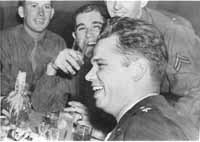 |
Maj. Malcolm “Muddy” Watters, Commanding Officer of the 457th Fighter Squadron. (From Larry Grennan) |
A second and final pass on the Field was made by Maj Watters' Dooley Blue flight. Following the main show a number of runs were made on Jap airfields in the immediate neighborhood. Col. Harper, Dooley Red Leader, strafed Yachimata and 4 aircraft of the 462nd delivered fire on parked aircraft, at Imba (the secondary target). It was at Imba that Capt Kensley N. Miller, a veteran of the African Campaign, made a head on pass into a revetment where it is believed he crashed and was lost. At either Togane or Maruto Airfield, a strafing run was conducted by 4 aircraft of the 458th. A field south of Kasumigaura, thought to be Ryugasaki, was the target of a 2 plane attack. Flak defenses of the primary target were described as moderate, light and medium, inaccurate; a similar verdict was passed on anti aircraft fire encountered at the other targets. At Kasumigaura, it was noted, the attack appeared to have caught the Nips with their G-strings down.. The net result of the mission, the farthest penetration of the Empire by fighter aircraft, was 1 destroyed and 2 damaged in the air; 5 destroyed, 1 probable, and 50 damaged on the ground. Such a score was subject, of course, to the assessment of the gun camera film by the Claims Board. When the gun camera films were exhibited a number of disturbing facts came to light. The pictures failed to confirm the ambitious damage claims. A number of hits were made, but exceptionally high speed and the temptation to spray bullets indiscriminately at a wide variety of targets greatly reduced the effectiveness of the fire.
On the Group's first pay dirt mission, it was only natural to expect the boys to shove the throttle to the fire wall, particularly in view of the detailed indoctrination of the strength of enemy flak given by the S-2 at the briefing. Older hands at the game were, however, much less impetuous. Observation of the film of Lt Willis of the 462nd , for example, veteran of some 80 missions in Africa, showed the damage that could be inflicted on the enemy by deck strafing with a P-51 aircraft. The final assessment submitted in the Squadron Claims Annex slightly reduced the estimates of the mission report. Enemy aircraft destroyed were listed at 1 in the air and 5 on the ground, probably destroyed 1 (ground) , and damaged 1 in the air and 42 on the ground which was certainly on the generous side. The most serious objection leveled against the conduct of the mission concerned the tactics that were employed, or to be more specific, the tactics that were not employed, during the strafing run. At the end of the pass over the target, the 506th planes were spread all over the map, "from Hell to breakfast", as one of the participants phrased it. They would have been duck soup for aggressive Jap planes.
Unit History 506th Fighter Group June 1945 VLR Mission No 15 (FC Mission #167 1 June 1945 - Black Friday)
>read the full story from the pilots that survived this mission<
Force: 148 P-51 of the 506th, 21st and 15th Groups
Mission: VLR Fighter Escort of XXI BomCom maximum effort against Osaka
Our losses: 27 planes lost. One pilot lost and 24 pilots missing.
Two aircraft losses were caused by mechanical failures and one plane was lost during an air collision with another plane. The remaining 24 losses were due to weather, either directly or indirectly. Then fighters reached a point approximately two hours away from home base they entered frontal area extending from surface to 23,000 feet, where zero visibility, intense turbulence, heavy rain and snow and icing conditions scattered the P-51s so badly that it was impossible to maintain communication contacts. Twenty seven of the fighters broke out of the front and continued over the target and 94 fighters returned to base. Twenty four pilots are missing. Two pilots who parachuted were picked up by ASR surface vessels; the fighters that were over the target reported very little enemy air opposition. Several enemy fighters were sighted too distant to attack, and only one Kick came within range. It was shot down. Penetration of the front was made on this mission only because the weather ship reported good weather and Group leaders assumed they would be in clouds only momentarily. The penetration of frontal systems has been systematically avoided, with the cardinal rule of "don't go on instruments, except in an emergency". This mission has constituted effective, though costly, experience in eliminating personnel errors.
(506th Group) VII Fighter Command Air: 1 Nick destroyed. Sea; 4 to 5 picket or fishing craft damaged, Katsuma bay. Ground: Radio station at Taichi strafed; radio station at Naga Hae strafed, and left burning.
LOSSES: 462nd, Capt. Lawrence S Smith, MIA; 1st Lt. G.L. Loomis, MIA; 1st Lt. A.C. Ridley, MIA. 457th, 2nd Lt. J.E. Best, MIA; 2nd Lt. R.H. Griffith, MIA; 2nd Lt. R.C. Klippel, MIA; 2nd Lt. L.J. Kloibor, MIA; 2nd Lt. W.E. Saks, MIA. 458th, 2nd Lt. R. Harvey, MIA. 506th, Lt. Col. H.J. Scandrett, MIA. Hq. Capt. E.M. Crenshaw, MIA.
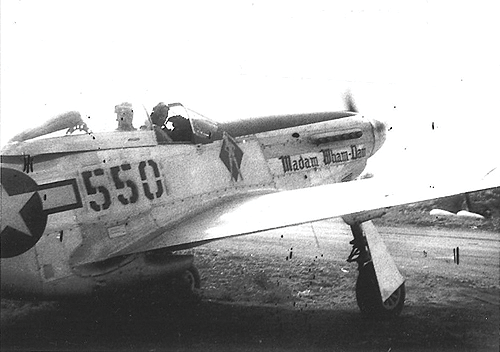
Between the 1st and the 7 of June the Group reposed on its collective derrieres awaiting a weather clearance for missions to the Empire. Several attempts were set a foot by the Fighter Command to inaugurate missions. On the morning of the 4th, an Osaka escort mission was scheduled for the next day; Later that morning notification was received that the target was changed from Osaka to Kobe. At 1430 that afternoon, VII Fighter informed us that the escort mission had been shelved and replaced by a possible strafing attack on an airfield in the vicinity of Kobe or Osaka. A few minutes later the mission was canceled.
As it turned out, the stretch of inclement weather which dictated the abandonment of the escort mission came at a most inopportune time. At Kobe on 5 June the B-29's ran into 150 to l60 Jap planes who made a total of 647 attacks on their formations. At a cost of 3 bombers destroyed and 18 damaged by fighters plus 3 more destroyed and 9 more damaged by flak and fighters and flak combined, the B-29's racked up a score of 44 destroyed, 22 probables () and 44 damaged. This score, incidentally, topped anything achieved to date (18) by escort missions of the Iwo based Mustangs. On the afternoon of the 5th word was received of an Osaka escort scheduled for the 7th .
>read the full story from the pilots that survived this mission<
VLR Mission No 16 (FC Mission #174) 7 June 1945
Force: 138 P-51s of 15th, 21st and 506th Groups
Mission: VLR Fighter Escort of XXI BomCom maximum effort against Osaka
Claims against enemy: 1 Nick and 1 S/E destroyed and 1 Dinah damaged in the air.
During the one hour and 15 minutes over the target there was slight enemy air opposition. Flak was heavy, meager and inaccurate continuously pointed around the target area at 16,000 to 20,000 feet with black and white bursts being seen. One P-51 was lost operationally 19 miles north of base on the route out. The pilot was picked up by an ASR destroyer and returned to base.
Aborts: Red 3, replaced by Spare 3; Green 4, replaced by Spare 1.
DAMAGE TO THE ENEMY: (506th Group) Air: 1 e/a destroyed, Lt. Col. Brown. LOSSES: None.
TARGET: VLR escort to Osaka area
NARRATIVE: The mission encountered a front 150 miles south of the DP, it was, however, fairly weak, and was crossed at 20,000 feet. The weather remained poor into the target area, which was blanketed by 9/10 low clouds. No Japanese fighters were encountered, though several bogies were called out but disappeared immediately into the cloud deck below. At the end of 30 minutes of patrolling over the stream of B-29s, the squadron turned toward the RP. Capt. Marcott, Blue Leader, in the act of scaring two bogies to cover, switched tanks and forgot his boost pump; his fuel lines air-locked, and by the time his engine was again running, he had lost the squadron. After flying in the general direction of the RP with a lone fighter from the 15th Group, he finally tacked onto the wing of a homing Dreamboat and returned to Iwo. Except for a thick layer of weather 170 miles north of base, which forced the squadron below 500 feet, the remainder of the trip was uneventful.
Supporting a maximum effort strike by the XXI BomCom, the 506th, 15th, and 21st Fighter Groups were to maintain patrol of the bomber route between the IP and the target. The escorting fighters, contrary to the practice followed on the weather hop of the 1st, were to be dispatched in shifts, with the 506th as the second serial, at intervals of 15 minutes. If business in and around the bomber stream proved to be a trifle slack the fighters were ordered to pick up an extra dividend by an attack on Jap airfields in the vicinity, Itami was selected as the 506th 's target. At the Group briefing at 2000 on the 6th the S-2, Captain Gilges, gave a general resume of the flak situation in and around the bomber target, concluding with the reassuring thought that the heavy AA guns would be primarily directed at the B-29's and that fire from these batteries encountered by the fighter escort, approximately 5000' from the bomber stream, would be extremely poor gun laying by the Jap AAA.
Detailed information on the defenses and dispersal areas at Itami was also presented. The plan of attack called for a repetition of the flak buster and deck strafing tactics followed at Kasumigaura in late May. Takeoff with 59 A/C — of whom 7 returned early — was accomplished at 0842 (19). Arriving at the departure point at 1200 the Group provided area protection for the bomber stream for about 1 hour and 15 minutes. A lone Jap SE A/C. blissfully unaware of the presence of our P-51's some 4000' above him was observed at 16000' Just S of the Target apparently directing AA fire on the bombers. A mad scramble for the Nip's scalp ensued between Lt Col Brown's flight and Lt Zagorsky's flight of the 462nd Squadron. Assorted passes were made by all 8 A/C with the result that the Jap, after several pathetic attempts at evasive action, disappeared in flames into the clouds. Results for all three groups were uniformly meager. In addition to the SE destroyed by the 506th, a Nick was destroyed and a Dinah damaged by the other outfits. (20) Flak over the Empire gave the pilots very little trouble. Miscellaneous bursts of heavy AA encountered at the DP, about 5 miles SE of the Ip, in the target area, and at the RP were described as meager and inaccurate. Results of the 2800 tons of incendiary and HE bombs dropped by the escorted B-29's included 3.4 square miles of the city of Osaka newly devastated. (21) While the Osaka escort was underway on the 7th, notification was received of a strafing mission on Meiji, Toyohashi, and Yamamatsu A/Fs. Two abortive weather missions and an untold number of postponements were incurred in connection with these targets during the remainder of the month. The first of the Meiji weather hops became airborne with 60 A/C at 0945 on the morning of the 8th (22).
 LETTERS FROM IWO JIMA: THE AIR WAR: June 8th: Pilot Down & Rescue
LETTERS FROM IWO JIMA: THE AIR WAR: June 8th: Pilot Down & Rescue
VLR Mission No 17 FC Mission #123 8 June 1945
Force: 104 P-51s of the 506thand 15thGroups
Mission: VLR Fighter Strike against airfields in the Nagoya area
The 506th together with the 15th Group scheduled to attack Kagamgahara, Suzuka, and Akenogahara, encountered & front some 60 miles on course reaching up to 28000' - 30000'. The Group returned to Base and stooged around the Island for awhile to get rid of some of their gas, before landing at 1134. The following day a routine Bonin Islands (Map ) strike was scheduled (23).
From A-2 of the Fighter Command a report was received of a boat 40' long having been sighted in the vicinity of Chichi. The 12 A/C plus Josephine and escort of the 457th were unable to locate the boat however, and unloaded their bombs on Sasaki A/F, on a radio station, and on what was described as a "large warehouse". A low level strafing job was conducted on several wooden ships (24).
VLR Mission No 18 (FC Mission #177) 9 June 1945
Force: 57 P-51s of the 21st Group
Mission: VLR Fighter Strike against airfields in Nagoya area
Claims against the enemy: 1 probably destroyed and 2 damaged in air; 7 destroyed and 15 damaged on the ground
Our losses: 3 planes with 2 pilots missing.
Two squadrons attacked Kamoyama airfield mistaking it for Kagamigahara, the primary target. Communications troubles and 8/10 clouds were factors which contributed to difficulty in identifying target. Third squadron strafed Kagamigahara, destroying 3 and damaging an estimated 11 enemy aircraft on the ground. Hangars, AW positions and other installations were also strafed. Retiring to the south, Okazaki, Toyohashi, Hamamatsu, Mikatagahara airfields were attacked, 4 additional enemy aircraft being destroyed and 4 damaged. One Oscar was probably destroyed in the air and 2 S/E were damaged. One 40 foot vessel was probably sunk and one 100 foot Sugar type boat was damaged. Two P-51s and two pilots were lost to flak in target area and 1 P-51 was lost 10 miles north of base on the return. The pilot was picked up. Several P-51s were holed by AW fire.
©506thFighterGroup.org. All Rights Reserved.
Many of the 506th pilots came from other theaters of operations (Mediterranean, Europe) many instructors and most experienced flyers of other aircraft than the P-51D that they were flying at Iwo. Here Captain JJ Grant 462nd with his P-40 fighter. (click to enlarge)
Picture taken from a B-29 Superfortress with P-51D Mustang fighter planes escorting her to Japan.
Webmaster Notes
Most images you can click for additional information
Numerous use of Bookmarking : Reference to Documentation : MAPS (designated so)
Glossary of Terms (informative, historical event information)
(webmaster note: you will find many original stories & photographs contained within this site. An extensive history of the 506th is being presented throughout the many historical pages created. Many of the photos and written text is from actual combat personnel of the 506th Fighter Group. There is several hours of reading material contained herein. Every attempt is made to reference credit were credit is due. Please contact the webmaster if you have any input as to reference material.
Letters From Iwo Jima: The Air War - aboard the Bloemfenstein somewhere in the Pacific Ocean heading for Iwo Jima. We are all rather anxious to get where we are going, to get to a place where we can unpack and fix it up and call it home for a little while. Most of us are anxious to start flying again - sometimes I think this flying business has gotten into my blood. I sure hope when peacetime comes that I can have a plane (of course a school teacher could not afford one) (JJ never did get his plane - he did obtain a Lt Colonel status in the Reserves but never flew after Iwo) All the enlisted men aboard got paid the other day. You could not walk around the decks without stepping into a crap game, a poker game or some type of game where they had a chance to increase their money.

Letters From Iwo Jima: The Air War
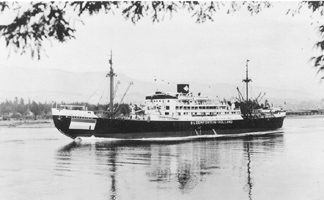
Aboard the Bloemfenstein somewhere in the Pacific Ocean heading for Iwo Jima. We are all rather anxious to get where we are going, to get to a place where we can unpack and fix it up and call it home for a little while. Most of us are anxious to start flying again - sometimes I think this flying business has gotten into my blood. I sure hope when peacetime comes that I can have a plane (of course a school teacher could not afford one) (JJ never did get his plane - he did obtain a Lt Colonel status in the Reserves but never flew after Iwo) All the enlisted men aboard got paid the other day. You could not walk around the decks without stepping into a crap game, a poker game or some type of game where they had a chance to increase their money.
Aboard Ship

Our traveling days aboard the boat are over as we came upon the Island one morning early and guys who had not gotten out of the sack the whole trip before breakfast were up and anxious to have a look. Its as we talked about where we were anticipating our final destination. Its as small as we figured it would be but much higher above sea level that we thought. Its all volcanic and and hard clay.<P> We stayed aboard ship a couple of days out in the harbor. Each individual who went ashore came back with tales of the number of Japanese still left on the island and how each night they were on the prowl.. they told of so many being captures each day and about the damage they had done. Everyone looked forward to landing with a great deal of anticipation. Grant of course drew guard duty guading the supplies and guarding the camp at night. The first night we did not have to go ashore for which we all breathed a little a sigh of relief. They starting disembarking our supplies right after we got here.<P>The next day they told us to be ready and at a moments notice. Finally about noon we boarded our barge and came ashore. The ships we came ashore on were fast like those that were in the invasion in which made history. They go full steam ahead right up on shore, let down a walk that is in the water aand when the waves have subsided you run like hell with your baggage. Then the Island. You sink into this ash right up over the low shoe Oxfords most of us were wearing. We grabbed a truck, loaded our supplies and sat down on the dusty old seats and headed from the camp site. There had been rain in the AM so the roads were fairly hard but I guess when its dary its real dusty.<P>We finally arrived at our temporary camp site, grabbed a tent, got all our luggage together and proceeded to set up our cots and our sleeping sacks. There are six of us that will use this little tent plus all our luggage, so its a little crowded. Here again everything is underfoot. Directly behind out area is a clay cliff with marks of battle, fox holes, and cave areas.. The boys soon discovered a dead Jap, some stray hands and legs, all just partially deceased and swarming with flies.
Second Day
Second day on our little island, have moved twice now and expect to move again. The organization here is not as good as in a boy scout troop I was in back home. The medical department is not setup yet; you can not even get a bandage for your finger, and any casualities have to be hauled off to the base hospital. Water is hard to get. they can have all they want but they have a poor arrangement of passing it out so we always seem short. We are on C rations and most of us have little fires to warm up the food we are going to eat. Everything is in cans. I had frankfurters beans for breakfast yesterday. This a.m. I had spaghetti with meat. We have large pipes dug into the ground for taking a leak. Our commode is a outdoor, open air job with ten seats, very public but you will use it and think nothing of it. I am still on guard duty and my outfit has it all night tonight, hope we do not have any Japs in the area. Today we are going scouting and we grabbed a ride up to the North end of the island with Treacy, Torg, Loomis and I. We got our 45s real handy and took off into the cliff country. Talk about a battle scarred area. This is really it. We walk up and down shell craters, here and there a cliff, then numerous cave areas that have been blown up. All around is war debris. Jap ammunition, gas masks, helmets, rations, saki wine bottles, field equipment, two toed sneakers, canteens, etc. Then we sight a corpse of a Jap. He seemed to be in a kneeling position. His guts had all been eaten by worms and these big green flys I was telling you about.
Letters From Iwo - May 7th Awaiting Airstrip to Be Built
Our other outfit, Balhourn and them were do in today but for some reason did not show up. You know of course they were our flight eschelon. We are going to have an air strip here on the island. We are all anxious to see them. Our softball team practiced this afternoon for about two hours, that is about the only thing we have to do for another few days. Then you know what will start happening. These C rations are starting to get monotonous. Thus building a fire has its drawbacks also. Tonight the Red Cross gave us a carton of cigarettes, 10 candy bars, 2 packages of gum, matches and a bar of soap, toothbrush and tooth paste. Guess if I live I will be a coach, up at Rome (New York). They tell me they need a good one (JJ would go on to be that coach at Rome and had over 20 years as the head football coach (had many an undefeated team), then Director of Athletics and finally became President of the New York State Athletic Association before he retired) . That radio is a life saver. Get Leyte, Shanghai, Saipan, short wave from states, Australia and Tokyo - music all day and no commercials.
Letters From Iwo - May 11th Flight Echelon Arrives
We have started to eat out of the mess tents now instead of our C rations. They have started building Quonset huts and a colsolidated Officers mess and housing area for the 48 of 52 officers in each Squadron. The plan also calls for an Officers club - we have plenty of supplies that we purchased back in the states and most of the boys are inpatient to get started. Our flight echelon came in yesterday May 11th (from Tinian). We came ashore April 25th. we have done most of the ground work in making the ara liveable and it sure was great ot see sonmew of the old gang again. the 462nd came in first led by the Colonel. The first fighters to land on airfield no. 3. There was a camera man to take pictures and a hell of a cross wind for them to land in. All planes and Squadrons got down safely. Soon we will start our misions and their then our troubles will start.
Letters From Iwo - May 14th B-29 Bailout
Today has been quite a day. Some of our boys were alerted for CAP patrol starting at 5:30 AM. Then at 10:00 AM we got paid and went directly to our lecture on air & sea rescue, bailing out over Tokyo, our attitude when and if we are a prisoner of war and the Jap treatment of prisoners. The weather is still stinking as usual. It is raining drizzling and being generally obnoxious. Our B-29's, 560 strong hit Nagoya today with incendiaries and the planes in distress that have landed here have told us that the majority of Nagoya was completely shrouded in smoke up to 15,000 feet. The ceiling was 19,000 feet, flak was intense and fairly accurate and only one enemy fighter was spotted. He made an air attack and pulled off to the side and bailed out. The ceiling has been varied from 50 feet to 150 feet. We have heard planes flying around here all AM and then ceiling lifted slightly so that could land and it was definitely a thrill seeing them handle those big babies as close to the ground. The landings were good, although very tricky and much could be said of the skill of the pilots. The engines all varied from inboards to outboards because of the low ceiling. I left the landing strip and headed for my tent. A B29 came overhead and down through the clouds came the boys in their chutes 1-2-3-4-5-6-7-8- and finally the ninth man came tumbling down with no chute open. He tumbled on down and nearly went out of sight before his chute opened. A little later a B-29 went over the area and the men bailed out in the bay. You could see them float down; down and finally hit the water. The ships in the area scooted out and picked them up. One boy had already floated his dinghy. It\'s strange to sit here and watch the havoc and destruction of war. We pray that all the boys get in safely, and the hell with the airplanes. It seems just a matter of course that chutes in the sky, emergency landings and burning planes. I hope this war ends soon.
Pilot down and Rescue
The story briefly is this. They had gone in North of Tokyo. They saw one enemy aircraft but all along the way they ran into flak. Concentrated and fairly accurate. They discussed later that they had gone in the same route as the B-29s had been using and the passage had been lined with heavy guns. They went in on the deck and concentrated flak fused to burst at 50ft kept popping all around them with the result that four ships did not return from our group alone. The other groups have not been accounted for.
Our missing pilot, a first lieutenant, his very first mission with this wife due to have a child in September suffered a direct coolant hit over the target and then bailed out over the Japanese mainland - we are hoping they have taken him as a prisoner. Freeman, a new boy, but more experienced, as soon as he got over the water started to burn. He bailed out and was seen to fall about 5000 feet. Meatball followed him down and saw him begin to cast out a die marker and start a smoke grenade. Meatball circled until the Dumbos picked him up it was reported at 3 AM this morning that Freeman has been picked up by Sub.
Mikes from group suffered a flak hit up over the RP rendezvous point. He was picked up as soon as he hit the water. Harrigan, the boy that had spent 50 hours in a dingy bailed out over the Jap mainland. All appear safe except Newby whose plane crashed and burned. One boy said he saw a shoot sailing to the ground about 2 miles distance from the plane but he was not sure. Many planes returned with flak holes and small ammo holes. One boy bailed out at about 150 miles from here. His wing had a hole in it. Another had a hole in his gas tank and landed in the water."left>
What a mission we had yesterday. Eight hours and 25 minutes, the longest group fighter mission ever flown and as for your fire aircraft. Course it wasn’t supposed to be going up we had to shoot skirt around a storm and there were coming back we got within a storm pocket, had to make a 180° turn and fly back north again, then east to get around the storm. You should hear the sigh of relief when we spotted a hole in the weather ahead. Those damn Japs don’t give us any opposition at all – we roam all over their damn country looking for parable and never get it. When we get back I played a game of ball – thank a few beers, took in a shower and slept like a baby all night. They have fresh water tubs that is a plus, alcohol rubdowns, osteopathic adjustments, really makes you feel good.
Remember Goss - he is here with P 47 group – he hasn’t changed a bit and is also a 1st Lieutenant yet. He had a flight but they gave it to someone else. His complaints are the same as ours. You have to come with someone you know with a little rank.
I'll close now honey. Hope the war ends soon so I can get back home and be with you.
<< Pop Up 13 - Enter Your Content Here >>
<< Pop Up 14 - Enter Your Content Here >>